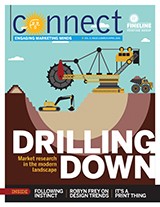Following Instinct: Striking a balance between intuition and data

By Charles Lunan
American business lore is rife with anecdotes of the entrepreneur who followed his gut and – against all the odds and naysayers – built a multi-million dollar brand. But if gut instincts – or intuition – are so critical to achieving the American dream, you may have to ask why half of all new small businesses fail within five years and three quarters of venture-capital backed startups never return capital to their investors?
The reason is that despite overwhelming evidence that outcomes improve when decision-makers engage in a more deliberative, data-driven process, we continue to base our decisions largely on quick, automatic and intuitive processes commonly referred to as “gut instinct.” Given the highly competitive and fast-moving nature of the marketplace, this should surprise no one. Marketers often have to make decisions on the fly, particularly online, where opportunities may only last a few hours. This makes it essential for marketers to recognize when they’re acting on gut instinct, how reliable it is and when they should supplement their intuition with a more deliberative decision-making process.
The role of instinct in a sea of data
In their 2004 paper – “When Should I Trust My Gut?” – Eugene Sadler-Smith and Erella Shefy noted that intuition comes from knowing and sensing. The former, or “intuition-as-expertise,” comes from knowledge and experience, and can improve with time. The latter, or intuition-as-feeling, is driven by emotions such as fear that may be irrational and hard to control.
While instinct may tell you the growing availability of data analytics are diminishing the role of intuition, Sadler-Smith and Shefy argue intuition provides “mental shortcuts” executives can use to quickly process a growing torrent of data and make decisions more efficiently.
This may explain why CEOs and successful entrepreneurs continue to list “good instincts” as one of their top reasons for their success. But not everyone should trust their instincts, says Paul Schwada, a managing partner at Locomotive Solutions and author of “8 Blocks: The Critical Realities for Growing Any Business.”
“Even those with good instincts – which isn’t really some inherent magic, but is usually the product of years of experience and careful analysis of what works and why – they can’t trust their gut all the time or entirely,” says Schwada, who suggests everyone develop a framework within which they can evaluate the accuracy and usefulness of their instincts.
“When we’re thinking about growth, especially, we are tempted by the gut, such as, “I just feel like we need to get to $20 million,” Schwada says. “A framework can force us to consider the critical angles – why we might need that, what it might look like, how we might accomplish it. It helps validate good instinct. It also shows us where we really need more data, and which data represents critical assumptions, meaning we have to make sure the data is correct and its subsequent insights are valid.”
Have HOPE
Striking the optimal balance between intuition and data is one of the greatest challenges facing marketers, says Lindsay Pedersen, a principal of LCP Consulting. “Creative evaluation is a subtle blend of art and science, heart and mind,” says Pedersen, who earned her marketing chops as a brand manager at data-driven Clorox. “This delicate, yet critical balance is not often taught. Thus, it’s a topic I’m often quizzed about.”
To help her clients navigate the creative review process, Pedersen has developed a three-step HOPE (Heart. On Point. Execution.) Framework. In the first step… Read more.
Featured in Connect Magazine, March/April 2016.
Read the full digital version here.


